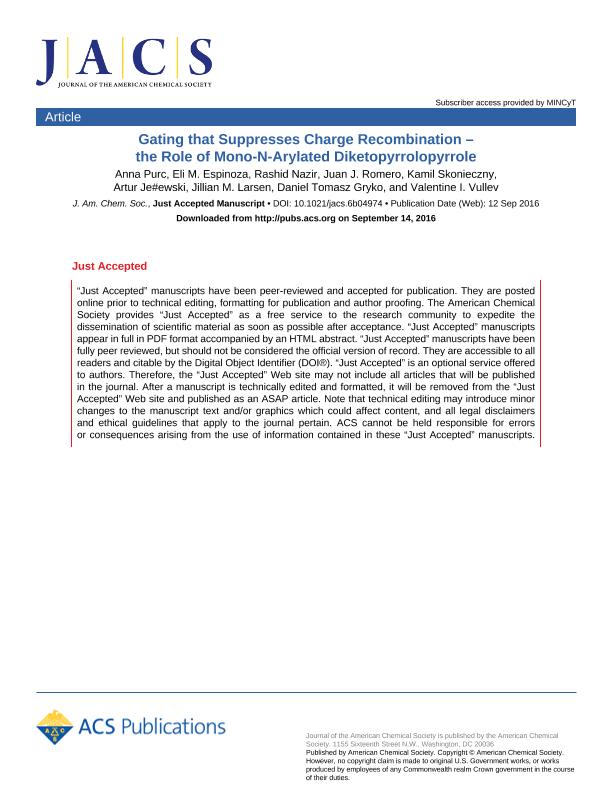Artículo
Gating That Suppresses Charge Recombination-The Role of Mono-N-Arylated Diketopyrrolopyrrole
Purc, Anna; Espinoza, Eli M.; Nazir, Rashid; Romero, Juan José ; Skonieczny, Kamil; Jezewski, Artur; Larsen, Jillian M.; Gryko, Daniel T.; Vullev, Valentine I.
; Skonieczny, Kamil; Jezewski, Artur; Larsen, Jillian M.; Gryko, Daniel T.; Vullev, Valentine I.
 ; Skonieczny, Kamil; Jezewski, Artur; Larsen, Jillian M.; Gryko, Daniel T.; Vullev, Valentine I.
; Skonieczny, Kamil; Jezewski, Artur; Larsen, Jillian M.; Gryko, Daniel T.; Vullev, Valentine I.
Fecha de publicación:
10/2016
Editorial:
American Chemical Society
Revista:
Journal of the American Chemical Society
ISSN:
0002-7863
Idioma:
Inglés
Tipo de recurso:
Artículo publicado
Clasificación temática:
Resumen
Suppressing the charge recombination (CR) that follows an efficient charge separation (CS) is of key importance for energy, electronics, and photonics applications. We focus on the role of dynamic gating for impeding CR in a molecular rotor, comprising an electron donor and acceptor directly linked via a single bond. The media viscosity has an unusual dual effect on the dynamics of CS and CR in this dyad. For solvents with intermediate viscosity, CR is 1.5-3 times slower than CS. Lowering the viscosity below ∼0.6 mPa s or increasing it above ∼10 mPa s makes CR 10-30 times slower than CS. Ring rotation around the donor-acceptor bond can account only for the trends observed for nonviscous solvents. Media viscosity, however, affects not only torsional but also vibrational modes. Suppressing predominantly slow vibrational modes by viscous solvents can impact the rates of CS and CR to a different extent. That is, an increase in the viscosity can plausibly suppress modes that are involved in the transition from the charge-transfer (CT) to the ground state, i.e., CR, but at the same time are not important for the transition from the locally excited to the CT state, i.e., CS. These results provide a unique example of synergy between torsional and vibronic modes and their drastic effects on charge-transfer dynamics, thus setting paradigms for controlling CS and CR.
Archivos asociados
Licencia
Identificadores
Colecciones
Articulos(INIFTA)
Articulos de INST.DE INV.FISICOQUIMICAS TEORICAS Y APLIC.
Articulos de INST.DE INV.FISICOQUIMICAS TEORICAS Y APLIC.
Citación
Purc, Anna; Espinoza, Eli M.; Nazir, Rashid; Romero, Juan José; Skonieczny, Kamil; et al.; Gating That Suppresses Charge Recombination-The Role of Mono-N-Arylated Diketopyrrolopyrrole; American Chemical Society; Journal of the American Chemical Society; 138; 39; 10-2016; 12826-12832
Compartir
Altmétricas



